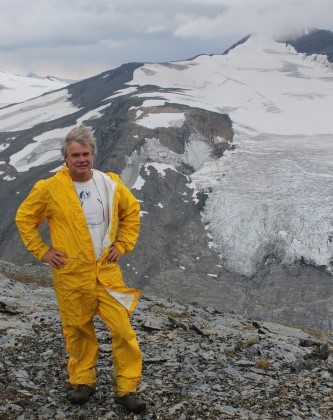Dr. Arnott’s research consists of two main parts: one experimentally oriented and the other applied. Our current applied research is studying the lithological make up and stratal geometry of deep-marine sedimentary rocks. Our principal geological laboratory is the (Neoproterozoic) Windermere Supergroup in the southern Canadian Cordillera where expansive, superbly exposed, glacially polished outcrops afford a truly unique opportunity to study deep-marine rocks at scales ranging from mm to km. Aside from academic interest, the study of these rocks has direct application to real-world questions and uncertainties related to deep-water petroleum reservoirs. Our experimental research is presently studying the effect of suspended sediment within turbidity currents. To do this we are sending live turbidity currents through a medical-quality CT scanner while concurrently measuring their 3-dimensional velocity structure. In combination these instruments are allowing us, for the first time, to accurately make the connection between flow mechanics and the various sedimentary textures and structures formed during deposition.
Selected publications
- Tilston, M*, Arnott, R.W.C., and Rennie, C.D. (in press). A time-frequency dependent method for estimating convection velocities and isolating turbulence using length-scale based filtering in unsteady flows. Journal of Fluid Mechanics.
- Terlaky, V* and Arnott, R.W.C. 2014. Matrix-rich and associated matrix-poor sandstone: Avulsion splays in slope and basin-floor strata. Sedimentology, v. 61, p. 1175-1197.
- Smith, M.D*, Arnott, R.W.C., and Ross, G.M. 2014. The Old Fort Point Formation: Redefinition and formal subdivision of a distinctive stratigraphic marker in the Neoproterozoic Windermere Supergroup, southern Canadian Cordillera. Bulletin of Canadian Petroleum Geology, v. 62, p. 1-13.
- Smith, M.D*., Arnott, R.W.C., and Ross, G.M. 2014. Physical and geochemical controls on sedimentation along an ancient continental margin: The deep-marine Old Fort Point Formation (Ediacaran), southern Canadian Cordillera. Bulletin of Canadian Petroleum Geology, v. 62, p. 14-36.
- Arnott, R.W.C. 2012. Turbidites, and the case of the missing dunes. Journal of Sedimentary Research, v. 82, p. 379-384.
